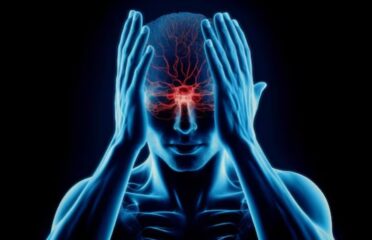Migraine
Overview

So, a migraine is like a super annoying headache that doesn't play by the rules. It's more than just a pounding head; it brings a bunch of friends like nausea, sensitivity to light, and even funky vision. It's like your brain throwing a temper tantrum, causing blood vessels in your head to act up. Triggers can vary from stress to certain foods or even the weather. Migraines can last for hours or days, making you want to hide in a dark room till it's over. Treatments range from meds to lifestyle changes, but they're quite a pain!
Symptoms
- Head pain that throbs or pulsates, often on one side
- Nausea or vomiting
- Sensitivity to light (photophobia) and sound (phonophobia)
- Visual disturbances or auras
- Episodes lasting hours to days, disrupting daily life
Causes & Risks
Migraine's exact causes remain unclear, but genetics and environmental influences play a significant part.
Alterations in the brainstem and its interaction with the trigeminal nerve, a critical pathway for pain, may be involved. There could also be imbalances in brain chemicals, like serotonin, which helps regulate nervous system pain.
Several factors can increase susceptibility to migraines, including:
-Family History: Having a family member with migraines increases the likelihood of developing them.
-Age: Onset can occur at any age, typically starting in adolescence and peaking in the 30s. Severity often lessens over time.
-Gender: Women are three times more likely than men to experience migraines.
-Hormonal Changes: Women might notice migraines linked to menstruation, pregnancy, or menopause. They often improve after menopause.
Test & Diagnosis
-MRI Scan: It's like a high-tech brain picture! This scan gives super-detailed images of the brain and blood vessels using magnets and radio waves. Doctors use it to spot things like tumors, strokes, infections, and other nerve-related issues.
-CT Scan: This one's like a series of X-ray snapshots for your brain. It helps get detailed pictures of the inside, spotting stuff like tumors, infections, brain damage, or bleeding causing those pounding headaches. These scans are like superhero tools for doctors to figure out what's happening inside your head!
Treatment
When dealing with migraines, it's important to stay hydrated by drinking plenty of fluids. This is especially crucial if vomiting is one of the symptoms accompanying the headache. Adequate hydration can help alleviate the intensity and duration of migraines, as dehydration can exacerbate the symptoms. Additionally, drinking water can help flush out toxins from the body, which can help reduce the frequency of migraines over time. It's recommended to drink water throughout the day, even when not experiencing a migraine, to maintain hydration levels and potentially prevent future headaches.
Living With
Living with migraines is like having an uninvited guest that crashes your party. These pesky headaches aren't just about head pounding – they're a whole package deal. Imagine wrestling with intense throbbing pain that makes you want to hide in a dark, quiet cave. Alongside that, the nausea can make you feel like tossing your lunch. Bright lights and loud sounds suddenly become your arch-enemies, and you might even see funky zig-zag lines or blurry spots dancing in your vision. You might try taking a quick nap, slapping an ice pack on your forehead, or guzzling down water like it's your sidekick to tackle these monster headaches. It's all about finding your secret weapons to fight these unwelcome migraine attacks.
Complications
Dealing with migraines is more than just a throbbing headache – it can throw some serious curveballs. These pesky headaches come with their own set of troublemakers. Picture this: intense head pain crashing your day, making you dive into a dark, quiet bunker just to cope. But wait, there's more! Cue the nausea, giving you a serious case of the queasies.
Suddenly, lights and sounds become your sworn enemies, triggering more discomfort. And sometimes, you might even experience visual disturbances, like trippy zig-zag patterns messing with your sight. Managing these migraine foes might mean sneaking in a power nap, slapping an ice pack on your head, or chugging water like it's your superhero potion. It's a constant battle against these troublesome migraine complications.





